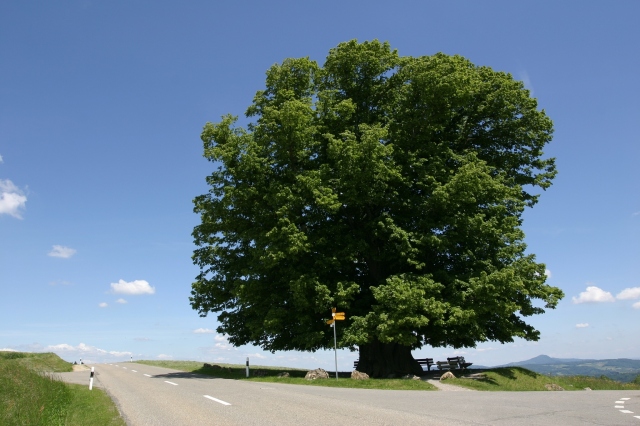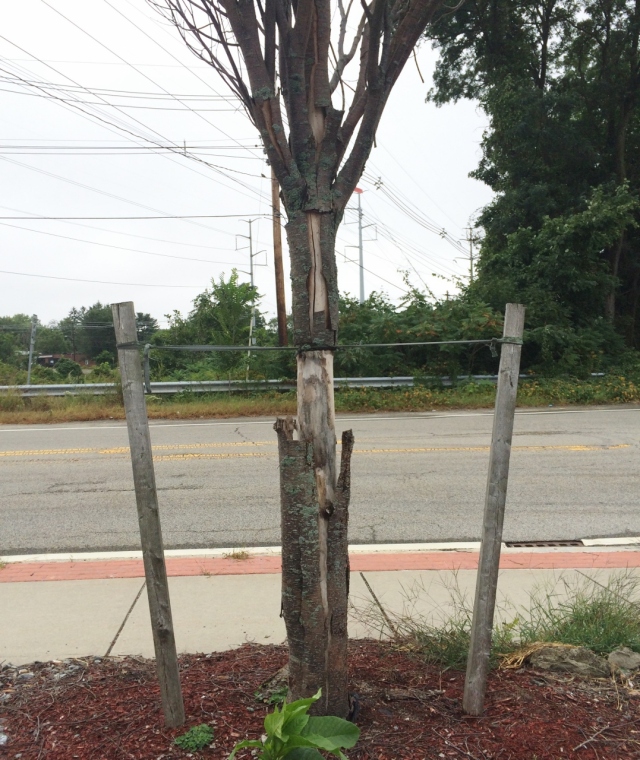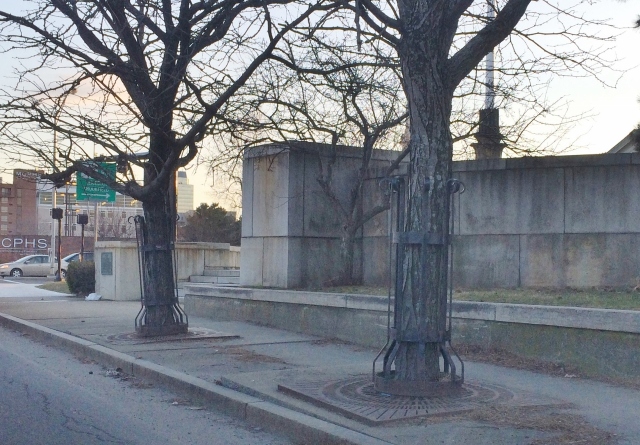
We all love trees in our built landscapes, but the odds are against their survival if we don’t follow a few simple rules. Although I’m not a horticulturist or urban forester, I’ve worked with people in those professions in the past and learned a lot from them. I’ve also attended lectures and webinars by renowned arboriculture expert, James Urban, from which I’ve gained valuable knowledge.
I’ve seen countless examples of trees that are improperly sited, planted, and/or maintained, which oftentimes has shortened their life span. Below I’ve listed some guidelines for design, installation, and maintenance that will increase the chances of your new trees thriving to a venerable old age, and keep existing trees healthy as well.
New Trees:
- Shade trees such as Maples and Oaks should be spaced at least 35 feet on center for healthy crown (canopy) development.
- Do not specify tree grates or guards. These will girdle (i.e. strangle) trees when their trunks outgrow the size of the grate hole or guard diameter. Better alternatives around the base of the tree are mulched areas, groundcover plantings, pavers on sand setting beds, or porous rubber surfacing, which the tree trunk can push away as it grows.
- Avoid specifying staking and guying, since the guys are frequently never removed, girdling and killing the tree as it grows. A tree cannot survive if its supply of water and nutrients is completely cut off. (This action occurs in the cambium layer, just beneath the bark.) Trees do not need stakes and guys unless they are planted in extremely windy sites or have abnormally small root balls in comparison to the size of their canopy. In these cases, make absolutely sure that the stakes and especially the guys are removed after the first growing season.
- Tree roots generally extend at least to the edge of the zone beneath the canopy of the tree, and often beyond that. Don’t limit the root zone to such a small area that the tree becomes stunted. Plan for its future growth where possible.
- When the budget allows, invest in modular subgrade cells and structural soils to prevent soil compaction where trees are sited in sidewalks, plazas, and other hard-surfaced areas. These allow roots to grow sufficiently beneath paved sites, resulting in much healthier trees than those planted without these systems.
- The planting hole should be at least twice the diameter of the root ball.
- If roots are pot-bound (encircling the root ball), they should be unwound and extended out from the root ball as much as possible when planting.
- The root ball should be set on firm soil so it the ball does not settle. The trunk flare, or collar, needs to be at least 3 inches above surrounding grade.
- After the root ball is set in the hole, the areas around the root ball should be backfilled with un-amended native soil. Tamp soil in place by hand. Water heavily before mulching, and fill with more native soil where it has settled. Do not place any soil over the root ball.
- Mulch should be about 3 inches thick, but no mulch should be placed within 6 inches of the trunk.
- Trees should be watered at least once a week during drought periods for the first two years after installation. This means thoroughly soaking the root ball by hand, and not relying on sprinklers!
Existing Trees:
- On construction sites, keep construction equipment and any other heavy objects away from the root zones of existing trees. I advise specifying/installing temporary fencing around the root zones for this purpose. Compaction of soil around roots will kill a tree.
- Do not specify any grading within root zones of existing trees (neither cut nor fill). Cutting will destroy roots; filling will suffocate them.
- Do not trench though a tree’s root zone, for installation of utilities or any other purpose. As mentioned earlier, this zone often extends beyond the tree’s canopy edge. The small feeder roots near the surface of the soil are just as important to the tree as its larger roots are. Cutting through any roots will often shorten the life of the tree.
All Trees (Old and New):
- Do not “volcano mulch” around trees (piling mulch high around the trunk). This can lead to rot and decay of the buried part of the trunk, and result in a tree’s death. As noted earlier, mulch should only be about 3” thick, and should not be placed within 6” of the trunk.
- Keep a mulch or plant bed around trees that are in an open lawn situation, instead of allowing grass to grow to the trunk. Turf adjacent to trees can be an invitation for overzealous weed trimming around the trunk, which can cut through the bark, particularly of young trees. If these cuts completely encircle the tree, this can result in girdling, leading to the tree’s death.
- If you’re going to hire someone to prune your trees, be sure to hire a certified arborist for this job, not just anyone with a chain saw. Improper pruning can compromise a tree’s health.
- Do not encircle a tree’s trunk and branches with strings of holiday lights, unless you plan to remove the lights after the winter season or holiday. If the lights are left in place indefinitely, the tree will be girdled as it tries to grow.

Death by tree ties

Trees outgrowing their grates and guards
Photo credits:
Top photo of large tree – Stefan Wernli (obtained from Wikimedia Commons)
All other photos – Alice Webb
